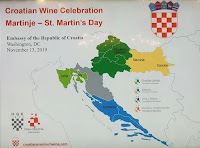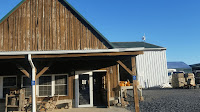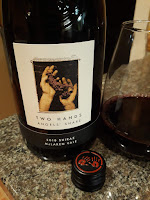On the days preceding and subsequent to Monday, November 11th, Europeans and Catholics celebrated the Feast of St Martin -- in honor of the patron of the poor, soldiers, conscientious objectors, tailors, and winemakers. One of these celebrations occurred at the Embassy of Croatia in Washington D.C. where
Croatian Premium Wine Imports poured several wines from the newly designated Komarna appellation to honor St. Martinje.
Saint Martin of Tours was born in Pannonia (present-day Hungary) in either the year 316 or 336 AD. His father was a high-ranking officer in the Imperial Horse Guard and a pagan, but at the age of 10, Martin converted to Christianity as the gospel expanded throughout the Roman empire. Roman law required full participation in military affairs so, at the age of 15, Martin followed his father into the cavalry corps were tradition claims he served in Gaul, Milan, and Trier (Treves).
His inspirational moment occurred while still young when he encountered a beggar in Amiens, France. The beggar was practically naked and freezing so Martin cut his cloak in half with his sword and gave one piece to the beggar and retained the other half for himself. That night, Martin had a vision in which Christ appeared to him and said: "Martin, a mere catechumen has clothed me.". A catechumen is one who undergoing the long process of instruction in the Christian faith but Martin was well aware of Matthew 25:45.
Afterward, Martin made clear to his superiors that he would no longer fight because of his Christian conscience. He refused his military pay and announced he would not join in future combat, thus becoming the first recognized conscientious objector in recorded history. He was accused of cowardice but Martin countered that to prove his sincerity he would ride into battle unarmed. Fortunately, a truce was signed shortly before an upcoming battle and Martin was subsequently released from military service.
He traveled to Tours where he began studying under an eventual doctor of the Church, Hilary of Poitiers. Over time he brought his Mother into the church and became a defender against the Arian heresy which denied the divinity of Jesus. He was forced to flee to an island in the Adriatic where he lived as a hermit for a while but eventually returned to Tours after the Council of Nicea. In 371, the faithful called Martin to the office of Bishop which he reluctantly accepted and served until his death in 397.
During his years as Bishop, Martin nurtured an immense love for wine and began blessing the beverage in order to make it more popular among laypeople. Throughout Europe, this tradition has continued with winemakers giving thanks to St. Martin for a good harvest. In Croatia, Martinje celebrates the day that must, or young wine matures into wine fit for drinking. But before indulging the wine must first be baptized and turned into chaste wine, since must is considered impure.

At the Croatian Embassy, the community celebrated St. Martinje and the indulgence of Croatian wine though the
Croatian Premium Wine Imports (CPWI). Their portfolio consists of wines from the Komarna winegrowing area where the vines were first planted in 2008 with a formal appellation designated in April 2013. The region is located in South Dalmatia between Split and Dubrovnik where the vines overlook the Adriatic Sea -- sometimes on 30-degree slopes. The grape varieties are primarily the indigenous Plavac Mali and Pošip with lesser amounts of international varieties Syrah, Chardonnay, Tempranillo, Cabernet, Viognier.

There are currently seven wineries in the Komarna appellation, and most unique, all seven are certified by the EU for organic production. This development was accelerated because the wineries starting near the same time and were able to leverage the same resources when surveying plots, planting the vineyards, and building out production and tasting room facilities. Economies of scale in action. Their youthfulness also allowed them to adopt the latest in technological advances pertaining to vineyard management and winemaking chemistry where even some laboratories are utilized by Croatian state wine officials.

During the St. Martinje Celebration, we sampled six wines from four of these winemakers:
Saints Hills,
Rizman,
Volarević, and
Terra Madre. Starting with the later winery, the Terra Madre selection consisted of a
Pošip 2018,
Plavac Mali Rose 2018, and a
Plavac Mali Premium 2015. Besides being unique in offering a rose, this winery is known for adding a small percentage of international varieties into their indigenous wines. They added a little structure using Chardonnay with the Pošip and roundness using the Cabernet Sauvignon with the Plavac Mali. In fact, the four Plavac Mali were all completely distinct in style with the
Rizman Plavac Mali 2016 being elegant with elevated fruit and the
Volarevic Plavac Mali 2016 being complex with a fruit on the tongue and spices and tannins dominating the tail. Finally, the
Volarevic Plavac Mali Gold 2013 is a bolder, full-bodied wine which consists of 30% raisined grapes and the wine aged 24 months in oak and four years in the bottle before release. Think raisins and figs and structured tannins.
The CPWI online store will be available very soon and will be augmented with Croatian wines from Istria shortly. Cheers to St. Martinje.
Update: The
Croatian Premium Wine Imports online store is now available.

 This month Cotton & Reed Distillery celebrated its third anniversary as DC’s First Rum Distillery. One of their many celebration activities included a release of just 102 bottles of 102-proof Sherried Cask Strength Rum ($50). The process starts with their White Rum ($29) made from Lousiana grown raw cane syrup and blackstrap molasses (6,000 pounds per batch) and fermented with a Rhum Agricole yeast strain and a Chenin Blanc yeast strain. The rum is then aged in used bourbon barrels just like their Mellow Gold Rum ($29). Afterward, the aging rum is transferred to PX Sherry-seasoned casks where PX refers to Pedro Ximénez grapes aged in a solera system where the grape brandy undergoes oxidative aging for an Oloroso. This process involves bottling some of the oldest casks, then refilling with grape brandy from younger casks. Cotton & Reed will follow a similar approach with their Sherried Cask Strength Rum augmenting their first cask with rum from a younger cask.
This month Cotton & Reed Distillery celebrated its third anniversary as DC’s First Rum Distillery. One of their many celebration activities included a release of just 102 bottles of 102-proof Sherried Cask Strength Rum ($50). The process starts with their White Rum ($29) made from Lousiana grown raw cane syrup and blackstrap molasses (6,000 pounds per batch) and fermented with a Rhum Agricole yeast strain and a Chenin Blanc yeast strain. The rum is then aged in used bourbon barrels just like their Mellow Gold Rum ($29). Afterward, the aging rum is transferred to PX Sherry-seasoned casks where PX refers to Pedro Ximénez grapes aged in a solera system where the grape brandy undergoes oxidative aging for an Oloroso. This process involves bottling some of the oldest casks, then refilling with grape brandy from younger casks. Cotton & Reed will follow a similar approach with their Sherried Cask Strength Rum augmenting their first cask with rum from a younger cask. In addition to their very unique Dry Spiced Rum ($29) that is infused with mostly gin inspired botanicals like juniper instead of baking spices, their Despaccino 2018 ($29) is delicious. The coffee beans come from Counter Culture which are then cold-brewed from Junius Coffee. The rum is also infused with rhubarb, dehydrated orange, and cacao all contributing distinct rich characters.
In addition to their very unique Dry Spiced Rum ($29) that is infused with mostly gin inspired botanicals like juniper instead of baking spices, their Despaccino 2018 ($29) is delicious. The coffee beans come from Counter Culture which are then cold-brewed from Junius Coffee. The rum is also infused with rhubarb, dehydrated orange, and cacao all contributing distinct rich characters. 
















































